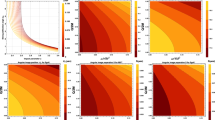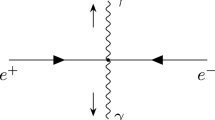Abstract
The shadow of rotating Hořava-Lifshitz black hole has been studied and it was shown that in addition to the specific angular momentum a, parameters of Hořava-Lifshitz spacetime essentially deform the shape of the black hole shadow. For a given value of the black hole spin parameter a, the presence of a parameter Λ W and KS parameter ω enlarges the shadow and reduces its deformation with respect to the one in the Kerr spacetime. We have found a dependence of radius of the shadow R s and distortion parameter δ s from parameter Λ W and KS parameter ω both. Optical features of the rotating Hořava-Lifshitz black hole solutions are treated as emphasizing the rotation of the polarization vector along null congruences. A comparison of the obtained theoretical results on polarization angle with the observational data on Faraday rotation measurements provides the upper limit for the δ parameter as δ≤2.1⋅10−3.









Similar content being viewed by others
References
Abdujabbarov, A., Ahmedov, B., Ahmedov, B.: Phys. Rev. D 84, 044044 (2011)
Abdujabbarov, A.A., Atamurotov, F.S., Kucukakca, Y., Ahmedov, B.J., Camci, U.: Astrophys. Space Sci. 344, 429 (2013)
Amarilla, L., Eiroa, E.F.: Phys. Rev. D 85, 064019 (2012)
Bardeen, J.M.: In: De Witt, C., De Witt, B.S. (eds.) Black Holes, Ecole d’ete de Physique Theorique, Les Houches 1972, pp. 215–239. Gordon & Breach, New York (1973)
Bardeen, J.M., Press, W.H., Teukolsky, S.A.: Astrophys. J. 178, 347 (1972)
Böhmer, C.G., Lobo, F.S.N.: Eur. Phys. J. C 70, 1111 (2010)
Bozza, V.: Phys. Rev. D 66, 103001 (2002)
Bozza, V.: Phys. Rev. D 67, 103006 (2003)
Bozza, V., Scarpetta, G.: Phys. Rev. D 76, 083008 (2007)
Bozza, V.: Gen. Relativ. Gravit. 42, 2269 (2010)
Cai, R.G., Cao, L.M., Ohta, N.: Phys. Rev. D 80, 024003 (2009)
Chandrasekhar, S.: The Mathematical Theory of Black Holes. Oxford University Press, New York (1992)
Darwin, C.: Proc. R. Soc. Lond. Ser. A, Math. Phys. Sci. 249, 180 (1959)
de Vries, A.: Class. Quantum Gravity 17(1), 123 (2000)
Eiroa, E.F., Romero, G.E., Torres, D.F.: Phys. Rev. D 66, 024010 (2002)
Enolskii, V., Hartmann, B., Kagramanova, V., Kunz, J., Lämmerzahl, C., Sirimachan, P.: Phys. Rev. A 84, 084011 (2011)
Falcke, H., Melia, F., Agol, E.: Astrophys. J. 528, L13 (2000)
Frolov, V., Snajdr, M., Stojkovic, D.: Phys. Rev. D 68, 044002 (2003)
Ghodsi, A., Hatefi, E.: Phys. Rev. D 81, 044016 (2010)
Harko, T., Kova’cs, Z., Lobo, F.S.N.: R. Soc. Lond. Proc., Ser. A, Math. Phys. Eng. Sci. 467, 1390 (2011)
Hioki, K., Maeda, K.I.: Phys. Rev. D 80, 024042 (2009)
Hioki, K., Miyamoto, U.: Phys. Rev. D 78, 044007 (2008)
Hořava, P.: J. High Energy Phys. 03, 020 (2009a)
Hořava, P.: Phys. Rev. D 79, 084008 (2009b)
Hyung, W.L., Yong, W.K., Yun, S.M.: Eur. Phys. J. C 70, 367 (2010)
Kraniotis, G.V.: Class. Quantum Gravity 28, 085021 (2011)
Klemm, D., Moretti, V., Vanzo, L.: Phys. Rev. D 57, 6127 (1998)
Konoplya, R.A.: Phys. Lett. B 679, 499 (2009)
Lobo, F.S.N., Harko, T., Kova’cs, Z.: (2010). arXiv:1001.3517v1 [gr-qc]
Luminet, J.P.: Astron. Astrophys. 75, 228 (1979)
Lü, H., Mei, J., Pope, C.N.: Phys. Rev. Lett. 103, 091301 (2009)
Mukohyama, S.: (2009). arXiv:0905.3563 [hep-th]
Narasimha, S.M.: Chitre Curr. Sci. 93, 1506 (2007)
Neves, J.S., Molina, C.: Phys. Rev. D 86, 124047 (2012)
Newman, E., Penrose, R.: J. Math. Phys. 3, 566 (1962)
Patnaik, A.R., Menten, K.H., Porcas, R.W., Kembal, A.J.: Mon. Not. R. Astron. Soc. 261, 435 (1993)
Pineault, S., Roeder, R.C.: Astrophys. J. 212, 541 (1977)
Quien, N., Wehrse, R., Kindl, C.: Spektrum Wiss. 5, 5667 (1995)
Saridakis, E.N.: Eur. Phys. J. C 67, 229 (2010)
Schee, J., Stuchlik, Z.: Int. J. Mod. Phys. D 18, 983 (2009)
Subrahmanyan, R., Narasimha, D., Rao, A.P., Swarup, G.J.: Mon. Not. R. Astron. Soc. 246, 263 (1990)
Takahashi, T., Soda, J.: Phys. Rev. Lett. 102, 231301 (2009)
Vázquez, S., Esteban, E.: Nuovo Cimento 119B, 489 (2004)
Visser, M.: Phys. Rev. D 80, 025011 (2009)
Zakharov, A.F., Nucita, A.A., De Paolis, F., Ingrosso, G.: New Astron. 10, 479 (2005)
Acknowledgements
The authors thank the TIFR and IUCAA for warm hospitality. This research is supported in part by the projects F2-FA-F113, FE2-FA-F134, and F2-FA-F029 of the UzAS and by the ICTP through the OEA-PRJ-29 project. A.A. and B.A. acknowledge the German Academic Exchange Service (DAAD), the Volkswagen Stiftung and the TWAS Associateship grants, and thank the Max Planck Institut für GravitationsPhysik, Potsdam for the hospitality.
Author information
Authors and Affiliations
Corresponding author
Appendix: Quantities in the locally non-rotating frame
Appendix: Quantities in the locally non-rotating frame
All physical quantities are indicated by parenthesis around the Greek indices in the locally non-rotating frame (LNRF). The components of \(k^{\mu}=dx^{\mu}/d\mu=\dot{x}^{\mu}\) which is tangent to the null congruence and its projections k (μ) on the LNRF are
The functions ν,λ,μ and ψ are listed as following
The nonzero components of the connection projected on the LNRF (Bardeen et al. 1972) are
Rights and permissions
About this article
Cite this article
Atamurotov, F., Abdujabbarov, A. & Ahmedov, B. Shadow of rotating Hořava-Lifshitz black hole. Astrophys Space Sci 348, 179–188 (2013). https://doi.org/10.1007/s10509-013-1548-5
Received:
Accepted:
Published:
Issue Date:
DOI: https://doi.org/10.1007/s10509-013-1548-5




